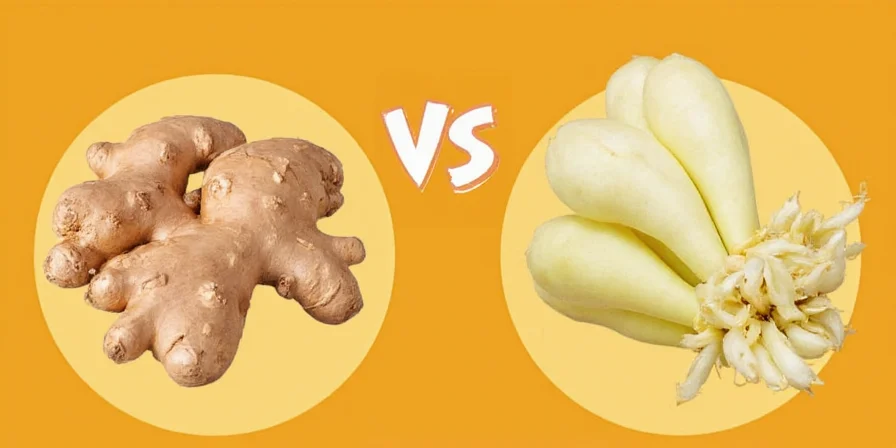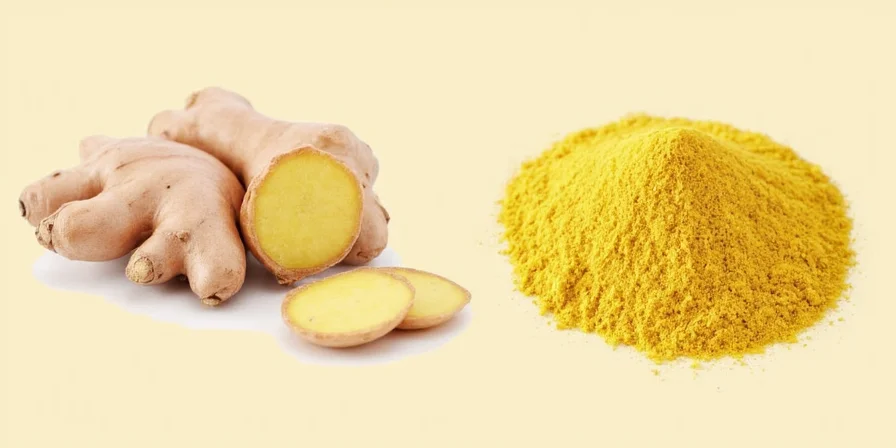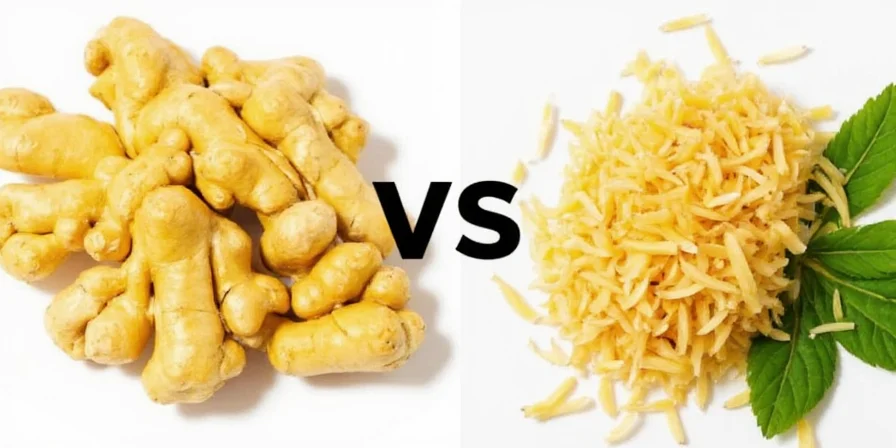
Table of Contents
- Introduction: Root Rumble
- Similarities That Fool the Eye
- Key Differences You Need to Know
- Cooking Hacks for Maximum Flavor
- Science Behind the Spice
- Cultural Significance: Beyond the Kitchen
- Storage Secrets: Keep 'Em Fresh
- Recipe Matchmaking: When to Use Which?
- Frequently Asked Questions
- Conclusion: Spice Up Your Kitchen Wisdom
Introduction: Root Rumble – Ginger vs Galangal
This guide delivers precise differentiation strategies for home cooks and culinary enthusiasts navigating Southeast Asian cuisines. You'll gain actionable techniques to avoid flavor compromises in authentic dishes—saving time, money, and preventing kitchen disasters when these roots are mistaken.
If you’ve ever stood in a grocery store staring at two knobby roots, scratching your head like a confused raccoon trying to open a jar, then congratulations—you’ve officially entered the spice world’s most sneaky showdown: ginger vs galangal.
At first glance, they look like botanical twins separated at birth. One minute you're making Thai curry, the next you're lost in an Asian market wondering if that's turmeric or just bad lighting.

Fear not—by the end of this guide, you’ll identify them with chef-level precision and understand exactly when substitution risks altering your dish's cultural authenticity.
Similarities That Fool the Eye
Let’s start with what makes these roots so easy to confuse:
| Feature | Ginger | Galangal |
|---|---|---|
| Appearance | Knob-like, beige skin | Smooth, pale skin |
| Plant Family | Zingiberaceae | Zingiberaceae |
| Cooking Use | Used fresh, dried, powdered | Mainly used fresh |
| Health Benefits | Anti-inflammatory, digestive aid | Antibacterial, antioxidant properties |
They're botanical cousins—but confusing them transforms delicate Thai broths into aggressively flavored experiments.
Key Differences You Need to Know
Now let’s break down where they part ways faster than a couple arguing over thermostat settings:
| Aspect | Ginger | Galangal |
|---|---|---|
| Taste Profile | Earthy, warm, slightly sweet | Pungent, peppery, piney |
| Best For | Baking, tea, Indian/Chinese cuisine | Thai, Indonesian, Vietnamese dishes |
| Texture | Soft, fibrous | Hard, crunchy |
| Active Compounds | Gingerol | Alpinetin, galangin |

Ginger provides gentle warmth perfect for sweet applications, while galangal delivers the sharp, resinous backbone essential for authentic Tom Kha Gai. Substituting one for the other fundamentally alters cultural flavor profiles.
Cooking Hacks for Maximum Flavor
- Grate It Like a Boss: Use a microplane for both roots, but note that galangal grates like wood—it takes effort!
- Slice It Thin: For soups or curries, slice both thinly—but don’t try to chew galangal pieces afterward unless you want a jaw workout.
- Dried vs Fresh? Ginger comes dried and ground; galangal should always be fresh. Dried galangal? That’s like using expired wasabi paste—do NOT do it.
- To Peel or Not to Peel: Ginger peels easily. Galangal? Try scraping with the back of a spoon. It's stubborn but worth the trouble.

Science Behind the Spice
Ever wonder why one root warms your body while another smells like forest after rain? Let’s geek out for a second.
- Gingerol: The star compound in ginger responsible for its fiery kick and anti-nausea effects. Also why pregnant folks reach for ginger candies.
- Alpinetin & Galangin: Found mainly in galangal, these compounds give it antibacterial powers and that unique herbal-pine flavor.
Translation: ginger is nature’s ibuprofen, while galangal is your kitchen’s secret immune booster.
Cultural Significance: Beyond the Kitchen
While both roots share Southeast Asian roots, their cultural roles reveal critical distinctions often overlooked in Western kitchens. Ginger features in Indian Ayurvedic rituals as a symbol of vitality during Holi celebrations, while galangal holds sacred status in Thai Buddhist ceremonies—placed on altars as an offering representing purity. This isn’t merely about flavor; using galangal in traditional Thai soups connects cooks to centuries of spiritual practice. Mistaking these roots erases cultural context, turning authentic dishes into unintentional fusion experiments. Understanding this dimension ensures your cooking respects culinary heritage while achieving technical precision.
Storage Secrets: Keep 'Em Fresh
You bought some fresh galangal for that one recipe, and now it’s been sitting in your fridge for weeks like forgotten gym memberships.
Here’s how to keep both roots kicking longer:
| Root | Refrigerator Storage | Freezer Storage | Other Tips |
|---|---|---|---|
| Ginger | Wrap in paper towel, store in sealed bag | Peel, chop, freeze in ziplock bags | Can also pickle or steep in honey |
| Galangal | Store whole in plastic wrap, up to 2 weeks | Grate directly into meals or freeze in cubes | Avoid cutting until needed |

Recipe Matchmaking: When to Use Which?
Confused about when to use which? Here’s your cheat sheet:
- Use Ginger If:
- Making gingerbread or carrot cake
- Brewing tea (especially with lemon + honey)
- Stir-frying Chinese dishes
- Adding warmth without sharpness
- Reach for Galangal When:
- Whipping up Tom Kha Gai soup
- Preparing Thai green or red curry
- Trying Indonesian rendang
- You want a sharp, aromatic backbone
Pro Tip: If a recipe says “fresh ginger” but you’re out—check if galangal might work. But if the dish specifically calls for galangal? Don’t substitute. Trust us. We learned the hard way.
Frequently Asked Questions
Can I substitute galangal for ginger in baking?
No—galangal's sharp, piney flavor overpowers sweet applications. Ginger's warm sweetness integrates seamlessly into baked goods, while galangal creates jarring flavor clashes in desserts.
Why does galangal taste so different from ginger despite similar appearance?
Different active compounds: gingerol (ginger) creates warm sweetness, while alpinetin/galangin (galangal) produce peppery, resinous notes. Their shared botanical family masks fundamentally distinct chemical profiles.
How can I tell if galangal has spoiled?
Fresh galangal should be firm with smooth skin. Discard if you notice dark spots, mold, or a sour smell—unlike ginger, it lacks moisture that masks early spoilage.
Is frozen galangal as effective as fresh?
Yes for cooked dishes—freeze grated galangal in oil cubes. Thaw directly into soups or curries. Never use frozen galangal in raw applications like salads where texture matters.
Conclusion: Spice Up Your Kitchen Wisdom
Mastery of ginger and galangal distinctions separates authentic dishes from cultural approximations. While they share visual similarities, their flavor profiles, cultural contexts, and culinary applications require precise handling. Armed with this knowledge, you’ll confidently navigate global recipes—preserving intended flavors and honoring culinary traditions. Remember: in Southeast Asian cooking, galangal isn't optional. It's the non-negotiable heart of authenticity.
Happy cooking, spice adventurers! 🌶️🌿











 浙公网安备
33010002000092号
浙公网安备
33010002000092号 浙B2-20120091-4
浙B2-20120091-4